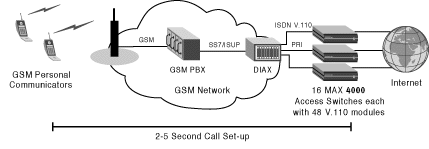
Sales Tools

European Carrier Offers GSM-based Internet Access
BackgroundA major European carrier realized there was a substantial market opportunity for cellular access to the Internet. The requirement was obvious. Business activities are becoming more dependent on the Internet while, at the same time, business professionals are becoming increasingly mobile. What was not so obvious was the best way to meet the needs of this growing market.
|
The carrier had already invested in a modern digital telecommunications network. Analog cellular technology, while adequate for voice calls, simply could not offer the throughput needed for data applications. While there are currently no international standards for digital cellular communications, the European market is fortunate to have a solid de facto standard: the Global System for Mobile, or GSM.
GSM is based on Time Division Multiple Access (TDMA) technology. Other parts of the world employ another fundamental technology: Code Division Multiple Access, or CDMA. Both TDMA and CDMA specify how multiple users share radio frequencies to transmit and receive data. Using Ascend equipment, this aggressive carrier pioneered an innovative GSM internet solution for the European market. |
Application
Current Approach The Need |
Analog Cellular Network

The Solution
A robust cellular Internet access offering required two major elements: a portable personal communicator; and a capable remote access server for the carrier. The key to both elements was integration. The user’s personal communicator would need to integrate voice and data capabilities in a hand-held device that fit into a pocket. The remote access server would need to integrate the many aspects of Internet access to make the service both dependable and affordable. The carrier also realized that because user equipment would change over the years, the key to long-term success would be an enduring network infrastructure at its Internet access point of presence (POP).
The best way to make its POP configuration endure, was to employ state-of-the-art technology. Because the service was new, the carrier was in a position to utilize the latest and greatest Internet access equipment, which provides full functional integration. The technical staff especially wanted to avoid a complicated interconnection of separate modem banks, terminal adapters, terminal servers and routers. They knew such an arrangement would be expensive, unreliable, difficult to install and hard to manage.
The remote access server also had to possess cellular-related features, specifically compliance with GSM standards and V.110 rate adaptation for fast connection set-up. In addition, because the carrier desired a solid foundation for the anticipated rapid expansion, the system would need to be scalable.
How it Works
|
For its POPs, the carrier selected Ascend’s MAX family of WAN access switches. The decision was actually an easy one. The MAX met all of the requirements and more, while Ascend’s dominance in Internet access provided field-proven use of the latest technological advances. Each MAX is a complete POP solution in a compact, rack-mountable chassis, making installation about as easy as it gets. A particularly powerful feature of the MAX is its V.110 digital modems, which support cellular modem traffic on the same high-speed E1/PRI trunk lines used for GSM’s digital cellular service. In the POP configuration, 16 MAX WAN access switches are connected via EURO ISDN NET5 PRI lines to the European GSM network. The arrangement provides Internet access anywhere in the world where GSM services are available. To minimize connection set-up time, the V.110 rate adaptation feature of the MAX is used. V.110 needs only 2-5 seconds to establish a connection, as opposed to 30-40 seconds required by the V.32 protocol. Cellular users appreciate the fast response.The subscriber element of the solution uses next-generation GSM-based mobile phones, such as the Nokia 9000 Communicator. The Nokia 9000 is an all-in-one unit that combines a cellular phone with built-in fax, terminal, e-mail and Web browser capabilities. The unit even has an integral notepad and an address book for convenience. Initially, with GSM Phase I performance at 9.6 Kbps, the solution is targeted at Internet e-mail users. Eventually, when GSM Phase II operating at 28-32 Kbps is available, the system will be suitable for Web browsing. Together the Ascend MAX WAN access switch and new cellular personal communications systems, like the Nokia 9000, have made the future of Internet access a reality today. |
Ascend Equipment The Benefits |
GSM Access – Ascend Solution

Copyright ©1998 Ascend Communications, Inc. All rights reserved.
![]()